This is a part of Discourse 2000, a blog looking at 2000AD story-by-story. It will include spoilers for all stories under discussion.
WHICH THRILL? 23rd Century cowboys head back to the Cretaceous to solve world hunger by farming dinosaurs. A lot of people get eaten.
JURASSIC AARGH!
There’s an important question behind this blog which I’ve so far been side-stepping a bit: are these comics actually any good? I’ve had good things to say about Dan Dare and Invasion! but the truth is I’m grading on a curve here: early 2000AD is hellaciously exciting in comparison to any other British boys’ comic of the time, but come to the class of ‘77 expecting the sophistication of even the mid-80s stories and you might be disappointed. Still, do one dimension well enough and you don’t need any others. When early 2000AD cooks, it really cooks, with a gonzo delight in its own outrageousness backed up with genuine care and craft.
This is still a comic built for 8-10 year old boys to read one issue of each week, though, and it was very effective at doing that job, which means there’s plenty of repetition, and resolutions take the shape of violent punchlines. Go in expecting that and you’ll have a great time. The fact that 2000AD can – and did – appeal beyond small boys is what made it special, but the small boy appeal came first.
In terms of quality, early 2000AD has several big things going for it, most of which are Pat Mills’ doing. We’ve talked about the opportunities created by longer story page counts, and the basic concept of street-level, anti-authoritarian protagonists in sci-fi settings. I should also mention the decision to go with hand-lettering rather than the typeset letters typically used on Action, Battle and the IPC Girls’ comics: it makes a huge difference to how organic and well-integrated the lettering and the art feels, and hand-lettering gradually became the norm after 2000AD’s success. And finally the layouts on the first few issues of 2000AD are extremely dynamic – there’s a reason most of the art extracts here have stray bits and pieces of panels appended, because the pages are composed as a whole to look as explosive as possible. That one wasn’t Mills’ doing – Art Editor Doug Church did the layouts for every strip in the early Progs, with a flair for action which helped teach the artists the kind of pages the new comic needed.
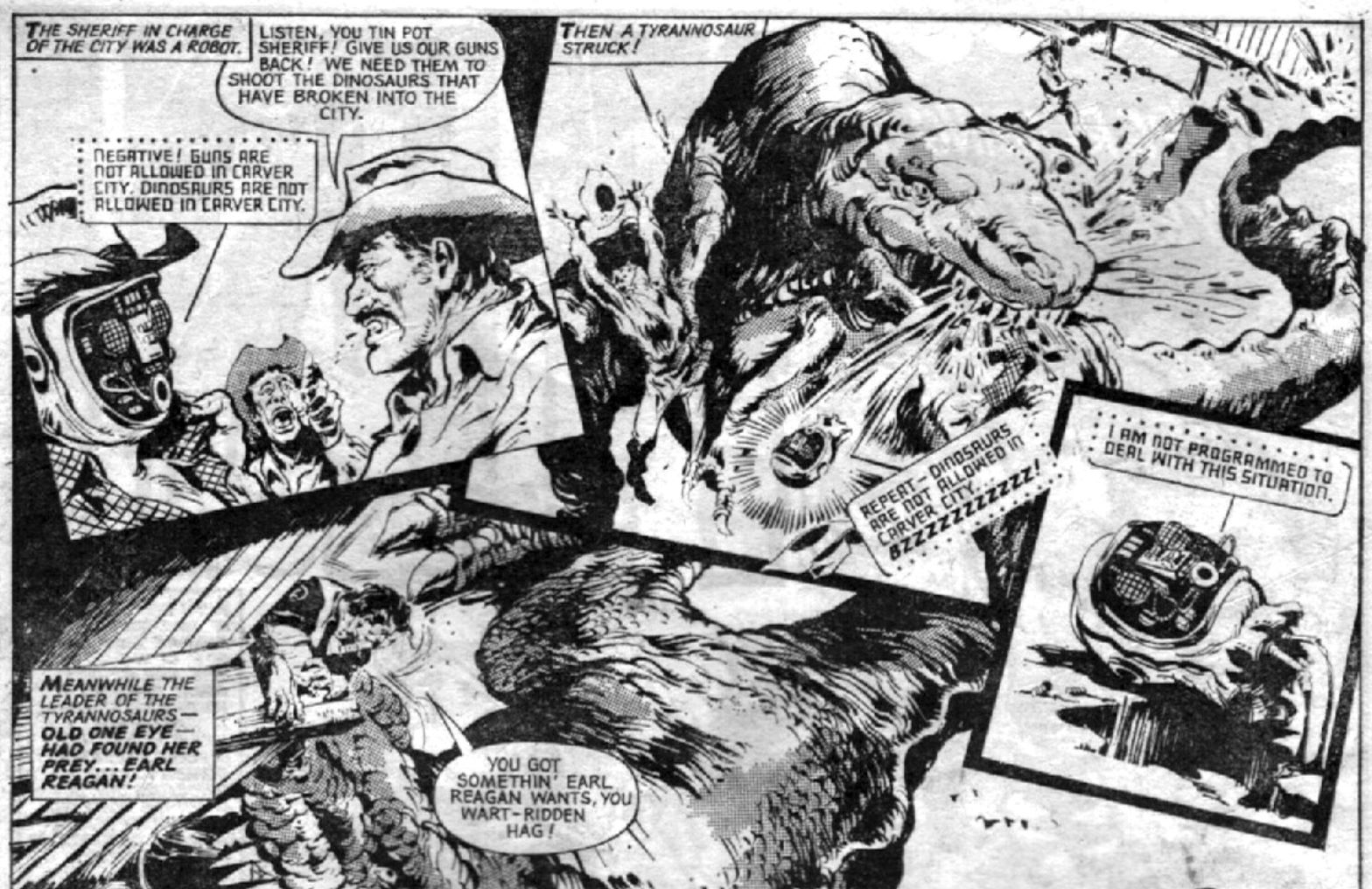
But there’s a difference between Mills making those breakthroughs and them delivering brilliant (or sometimes even good) comics on a weekly basis; and besides, those are ingredients in what will become classic 2000AD, but they aren’t the full dish. Prog 1 of 2000AD genuinely is a great comic, because it’s a masterclass in how to introduce characters and ideas. And it’s a manifesto for great comics because of that. But it’s not a manifesto which actually produces greatness on a regular basis for a while.
I’m talking about this now because there’s an exception to this, the launch strip which most closely approaches greatness: Flesh. This story about time-travelling 23rd century ranchers harvesting dinosaurs for food to satisfy future lust for meat is the shortest-running in the initial line-up – a compact 19 weeks of guys being eaten, clawed, poisoned by giant spiders, impaled on pterosaur beaks, et cetera. Even then it has the usual merry-go-round of writers and artists (the reprints credit some episodes to “R.E.Wright”) which generally means big swings in quality. That’s kind of true in Flesh too, with basic questions like “how large is a Tyrannosaur?” getting wildly different answers. But in Flesh the week-on-week chaos doesn’t matter nearly as much, because, unlike its Prog 1 stablemates, the story is built around ideas, and themes, and a wider story of a society at a crisis point.
This is one of the great opportunities an SF comic allows if, like Mills, you have a penchant for anti-authoritarian heroes. Implicit in the idea of the anti-authoritarian is the idea that there are authorities, and these authorities are wrong, corrupt, undeserving of their power. As mentioned in the Invasion! entry, there are very few 2000AD stories which start from the idea that things have improved. But in a story set in the present or the historical past, that’s as far as the concept can really go: your hero can go against the grain of the system, spit on its rules, and win victories over individual faces of it, but they can’t bring the whole thing down. Fantasy and SF, though, allow you to tell stories about collapsing systems and overthrown authorities – if you’re prepared to let those stories end. Mills’ two most successful series for 2000AD, Nemesis and Sláine, both star system-destroying protagonists.
The system in Flesh is corrupt and unsustainable. What’s great about it is that the story of the comic is not just the story of time-traveling cowboys fighting dinosaurs – though that’s an absolute banger idea even with no wider themes. Flesh is instead the story of that systemic unsustainability, as the smarter elements among the Trans-Time Rangers realise that over-farming prehistoric herbivores has created a food chain crisis of berserk, starved meat-eaters, and the short-sighted bureaucrats and profiteers who run it don’t see the catastrophic implications of this until they end up in the jaws of death themselves (still yelling about profit – this is not a subtle comic). Over five months of comics, the crisis plays out, and not to the humans’ advantage.
STRONG FEMALE LEAD
The fact that Flesh is the story of a system as much as the story of the people in it guides its choice of protagonist. There’s an interesting aside in Pat Mills’ book about how the most successful 2000AD strips tend to be named after the hero – when he later brought back Invasion!, the editor suggested the name change to Savage. But Flesh consciously breaks this rule. It’s a story named after the lead characters’ motivation, the resource all of them are willing to kill for.
In the first episode it looks like the hero of Flesh might be easy to identify. It’s Joe Bronkowski, rookie dinosaur herder who learns the hard way how dangerous the prehistoric world is. Or maybe it’s Earl Reagan, his more battle-hardened boss, who fits the rugged, working-guy template of the 2000AD hero. A couple of episodes in we meet Claw Carver, who’s every obviously an antagonist – he’s constantly on the take, only interested in personal gain and betrays other characters without thinking. But physically he’s the kind of man who would make a great action hero, having lost his hand to a velociraptor, killed the beast, and replaced his missing limb with the dinosaur’s own claw.
But by then we’ve been introduced to our actual lead character – the 120-year-old she-Tyrannosaur Old One Eye, Reagan’s nemesis and the de facto leader of the dinosaur army. Initially she’s just a particularly ancient and gruesome dinosaur – the story makes much of her warts and breath, and she’s constantly referred to as “hag”, summoning up imagery of witchcraft and the supernatural (a link made entirely literal when a clone turns up in a later Mills-written story: he’s called Satanus and has magic blood).
Old One Eye dominates the page like she dominates her pack – as with Belardnelli’s centre-spreads on Dan Dare, she’s an example of the extended story page count paying off, with several instances where a full length portrait of One Eye in her savage grandeur fills a whole page and the rest of the action has to happen around it. The strip’s artists get into the brief of an ancient, battle-scarred tyrannosaur with some of Old One Eye’s own gusto – she is a truly monstrous figure, a hulking form covered in lumps and scars and knobbles, giving the impression that every inch of her hide has at some point been ripped apart then scarred over.
The artists on Flesh are all drawn from 2000AD’s Spanish contingent – Joan Boix begins the strip, but most episodes come from Ramon Sola, who had creature-feature experience as the regular artist on Action’s rampaging-shark strip Hook Jaw. As 2000AD evolved and picked up the generation of British artists most associated with it, the Spanish contingent began to fall away, getting more regular work from IPC’s other comics. But they were popular with the early editors and for good reason – Kelvin Gosnell has talked about how their training in figure work was more extensive, which meant they delivered comics at a high basic standard of storytelling, a life-saver in the tight, small-panel world of traditional British comics.
Sola offered something a little different, though, which made him especially strong on a strip like Flesh. Where he excelled was in moments of chaotic, visceral violence – the point in the story where the human order breaks down under the sheer will to destroy of jaw, paw or claw. The Goya of the animal-rampage genre, Sola’s figures are often wild, extended and cartoonish, and his animals are a blur of slashing lines and shadow. Mills, whose vision of Flesh and other beast-based stories was rooted in this conflict between man and nature, called Sola a genius, and for this type of strip, he was.
Mills described his creation Hook Jaw as an “ecological” story, and he had a point, inasmuch as Hook Jaw spends an awful lot of his time beating up oil rigs. But the tag is better applied to Flesh, a story about an ecosystem, humans’ meddling with it, and the disastrous consequences of it, not least for the humans. The most famous fictional model of “humans go back to the Cretaceous and fuck things up” is Ray Bradbury’s 1952 story ‘A Sound Of Thunder’, which Flesh is in brutal conversation with. In Bradbury’s story, a minor incident in deep time alters the present in dreadful but incomprehensible ways. In Flesh, nobody involved gives a shit about changing the future, only extending the rapacious machines of human consumption back into the past to loot it. In fact, the story occasionally implies that the predations of the Trans-Time Corporation are what actually results in the extinction of the dinosaurs – despite the retributive carnage at the end, humanity has extracted too many pounds (well, tonnes) of flesh from the dinosaurs and the doom of both species may now be sealed. The sheer, profit-driven short-sightedness of the Corporation is one of the parts of Flesh that has aged horribly well – one of the story’s most famous images is of a human and tyrannosaur hybrid, fused together somehow by the time jump back to the 23rd century, an unforgettable visual indicator of how gut-level wrong Trans-Time’s meddling is.
And then, just to bulk the thematic load up even more, Mills makes the humans cowboys.
WHERE THE STYRACOSAUR ROAM
Pat Mills’ techniques and idiosyncrasies as a writer are something this blog will come back to again and again, particularly once he steps back as an editorial presence and becomes one of the comic’s backbone of writers. One very obvious thing you notice about his work, though, is that even by the standards of 2000AD and boys’ comics, it’s ferociously direct. When Pat Mills uses a story to make a point, it stays made. Mills, at least on 2000AD, is not usually a subtle storyteller. But directness doesn’t preclude thought or complexity. Mills has topics he’ll return to repeatedly in 2000AD, turning them over from different angles, finding echoes and mirrors across at least a decade of work.
One of the big things Mills is interested in is colonialism. A recurring set-up in his 2000AD stories is an occupying power pitted against indigenous peoples. It shows up in the ABC Warriors, in Nemesis (repeatedly), and in Sláine, before the mask of metaphor drops for his late-80s Crisis opus Third World War, about near-future teenagers fighting corporate proxy wars in Central America. But the anti-colonial axis in his work is always at an angle with the anti-authoritarian axis, and he’s most interested in where the two rub against each other. Mills’ iterations of his anti-colonial set-up tend to be full of morally gray, corrupt or simply ineffective leaders on the ‘good’ side, and are also regularly concerned with the experiences of the footsoldiers on the ‘bad’ side. (Grant Morrison’s The Invisibles is in many ways the most Millsian comic not actually by Pat Mills, though unforgivably lacking in people being eaten by dinosaurs)
This explains a lot of what’s going on in Flesh. The Trans-Time Rangers are cowboys because cowboys fighting dinosaurs is an amazing visual hook for a kids’ comic, and because writers can have a lot of fun with tropes like the drunken frontier town Doctor (“Joe’s recoverin’… He’s the first patient who ain’t died on me!”). But they’re also cowboys because what Mills is evoking with this set-up isn’t just the Western genre – of which more when we get to Dredd – but the actual history of the American West, specifically the slaughter of the American bison in the 19th Century. Vast wild herds of animals hunted to near-extinction by colonisers, with catastrophic effects on the traditional hunters and herders of these beasts. The result is war. But we’re seeing the war from the “footsoldier” perspective of Reagan, Carver and Bronkowski, three guys of distinct skills, experience and morality caught up in the disaster.
(If you think the buffalo analogy is accidental, check out the 1978 2000AD Annual, which includes a Flesh story – presumably set before the main series – in which Reagan and Carver are actually sent back to the 19th Century Great Plains to bring in some vintage buffalo meat. Or maybe don’t check it out, as it’s terrible, almost certainly nothing to do with Mills – the writers of the Annual’s filler strips are mostly unknown – and has nothing interesting to say about the strip’s ideas.)
So Mills has two metaphorical frameworks overlapping here: the ecological one, of meddling humanity against the power of nature, and the colonial one, of cowboys re-enacting the annihilation of the West’s native fauna and way of life. The two are not a completely comfortable fit, mostly because they ask Old One Eye to be both the avatar of nature’s vengeance and a native war leader, an overlap which could easily slip into dubious territory if actually pushed. But in this book at least, the writers don’t go there, and the main priority of Flesh remains its grand guignol reckoning with Trans-Time’s hubris.
BASE UNDER SIEGE
In the Invasion entry I talked about story destinations – ways to end strips which were built to be of indeterminate length if plans change or reader distaste merits it. We don’t have many mentions of how well Flesh did with readers, but it seems to have been popular – even so, out of all the opening 2000AD line-up, this is the one which feels planned as a shorter-running story, with the climactic siege on the Trans-Time base very obviously where the strip is heading from early on.
I’d guess it wasn’t quite so planned, and it’s the skill with which Mills and Kelvin Gosnell build up and execute the siege that makes it feel as if the whole story has been heading towards this final confrontation with Old One Eye. It’s easy to imagine a bunch of shorter Flesh episodes and incidents along the lines of the tourist time train which gets attacked by dinosaurs – in a rare concession to decency, the strip has a spoiled brat tourist gobbled-up out of reader sight, but gobbled up he is.
But while there’s evidence for, and room for, the usual episodic chaos in Flesh, its actual brevity works strongly in its favour. As does the shuffle of writers and perspectives early on, with the comic not settling on its central conflict until several weeks in. It means the strip shifts quickly from early and effective world-building – like the flesh-dozer with its absurd maw of knives, as happy to mince and package careless workers as it is dinos – to a desperate, accelerating story as Reagan and company try first to warn, then to defend the base. There’s no time to pull the story away from its thunderous trajectory, which means there’s also no time to dilute the central ideas and themes.
The result is a comic that feels richer, denser and more thought-through than everything around it, bar maybe Judge Dredd. But the pace of Flesh means it manages to wear this richness very lightly indeed: its themes are certainly there, but the story also worked as a weekly dose of man vs dinosaur mayhem, with the typical Mills-influenced blend of trust-me-on-this creature info and bone-crunching savagery. It’s the first 2000AD strip where you fully realise how good it is when you read it as a whole, not on a Prog-by-Prog basis.
Flesh also has one of the great 2000AD endings. Mills, who finishes his dino-baby off here and scripts the last episode himself, is at pains to avoid the “King Kong ending” – a defiant death for Old One Eye against the human forces, even though that’s where the story seems to be heading. Instead, the humans are dead or defeated with an episode to go, and the strip turns into an elegy for the she-tyrannosaur, tracking Old One Eye’s final journey to the Tyrannosaur’s Graveyard where she will lie down and die of old age.
Mills teams up with Ramon Sola to make her passing a special one – and once again we see how important it is to have those extra pages of story, which give him the chance to draw out Old One Eye’s final journey across three pages of narration, including a “fatal heart attack” which leaves her being eaten by scavengers, at which point she simply gets up, tears them apart in one final Sola-drawn frenzy, and staggers on for three days before dying – “THE GREATEST MONSTER OF ALL TIME!”. And there’s more – a perfect coda set in a 20th Century museum which is hosting Old One Eye’s skull, letting Mills shift from triumphant elegy to black humour across these final pages and end Flesh on a last, gruesome punchline.
Flesh would return in little over a year, but there’s no sense of that from the closing episode here: the most original strip in the starting line-up had made its point and ended well. Strips ended all the time in British comics – sometimes hurried to a conclusion when readers turned against them, sometimes closing because their comic was marked for one of IPC’s endless mergers with another title. Flesh, though, gives every impression of ending deliberately, on a high note. A new, and apparently similar, monster story about a polar bear stood ready to replace it.
Flesh’s pace and brevity saves its execution from ever sagging, but the heart of its quality lies in its ideas. Everything else in the early 2000AD is either a revival of old characters or plots, or a crib from a popular film. Despite a bit of shared Hook Jaw DNA, Flesh really stands alone as a story with a high concept but also some delightful world-building. One of the best Flesh-related things is a full-colour page by Kevin O’Neill which ran on the back of the comic one week, framed as an advert by Trans-Time Corporation detailing the wonders of their Cretaceous farm. It’s an early glimpse for readers of the deliciously odd, cartoon-steampunk way O’Neill draws machinery, especially the picture of a plump Triceratops being lowered into the Flesh-Dozer. It shows the real enthusiasm and care the staff had for the comic in general and perhaps this odd little strip in particular. It’s also decidedly on the nose about the story’s themes, complete with a “MAN IS THE REAL MONSTER” text box conclusion next to a sweltering grotesque chomping into his dino steak.
You can imagine a Volgan propaganda poster, or a map of Mega-City One, or a Rules Of Aeroball info-page taking up space at the back page, but I think the fact O’Neill (presumably a colour page short) went with Flesh is telling. Flesh’s marriage of trashy exploitation and big ideas masks the fact that it’s 2000AD’s most straightforward science fiction story – SF not in the Dan Dare sense of a strip with spaceships and lasers, but in the more literary sense of something that extrapolates something about future society then builds a story around that. There is a lot of the “Sweeney-Fi” tough guy storytelling in Flesh – the two lead humans are even called Reagan and Carver, after Sweeney protagonists Regan and Carter – but the strip is also a harbinger of the turn to SF we’ll see in the comic in 1978, with a succession of short-run stories that have clearer SF roots. It’s no spoiler to say they have trouble matching Flesh’s impact: the Hag Monster remains undefeated.
HOW TO READ IT: The complete Flesh Book 1 and Book 2 (which will get its own post in the 1978 season) are available as a collected edition from the 2000AD webshop.
RECOMMENDED?: Yes! Flesh Book 1 is the best of the five launch strips and the purest complete expression of very early 2000AD, even if selected Invasion! and Dredd one-offs have it beat.
NEXT PROG: John Probe gives Britain’s enemies a bit of needle in M.A.C.H. 1! The most popular launch strip with readers, so it must be good, right? Right??
Flesh and 2000AD (c) Rebellion
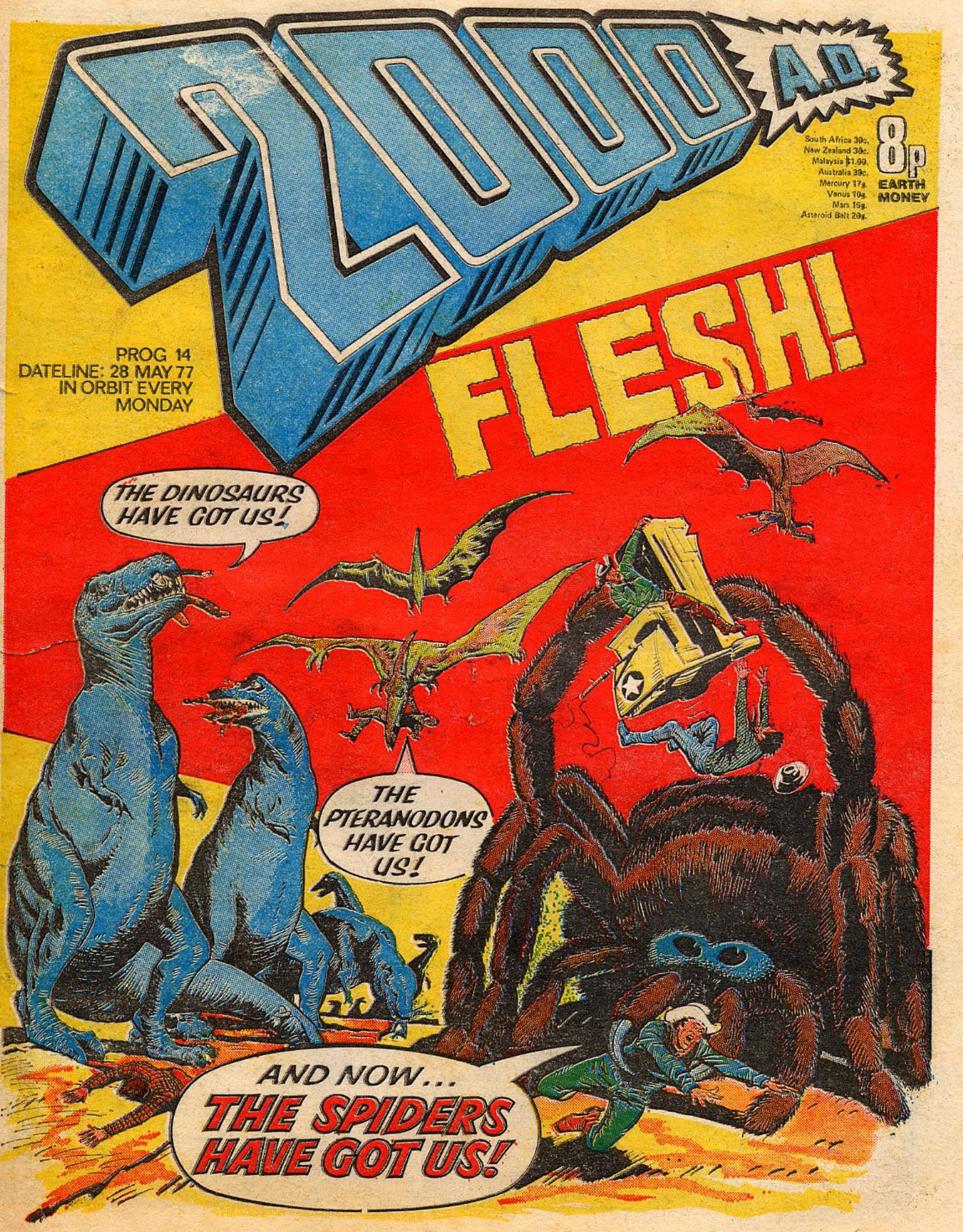
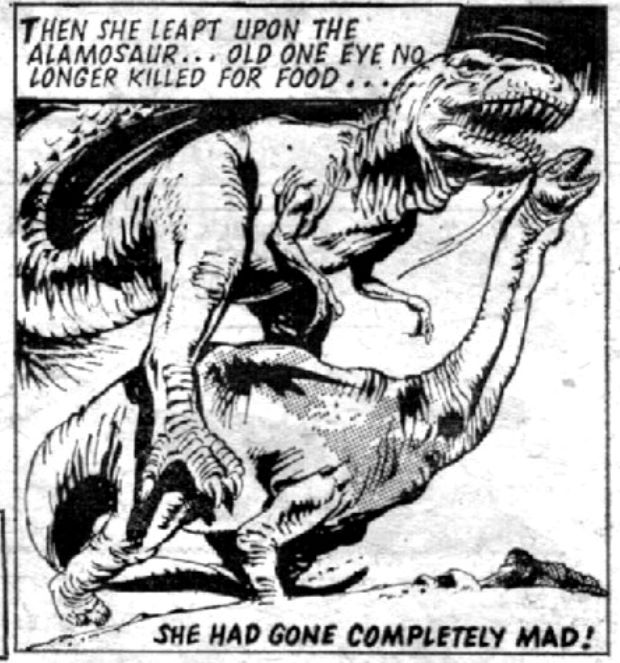
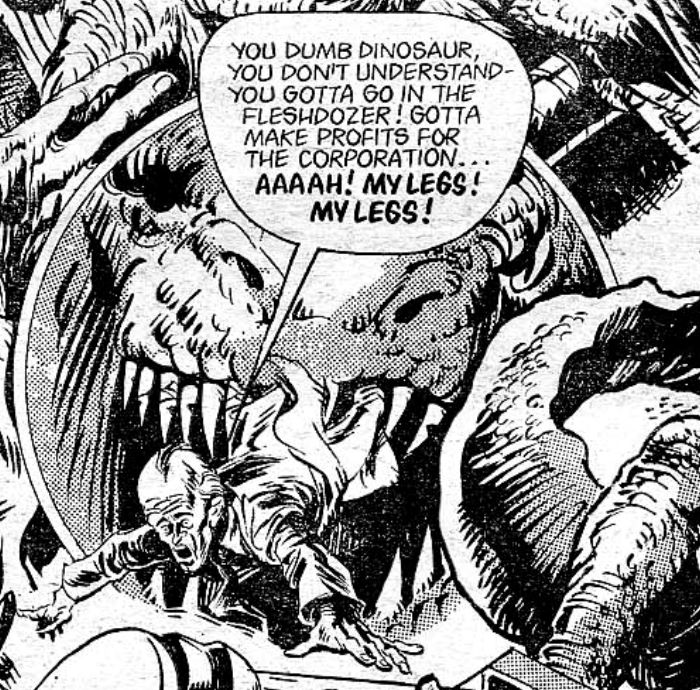

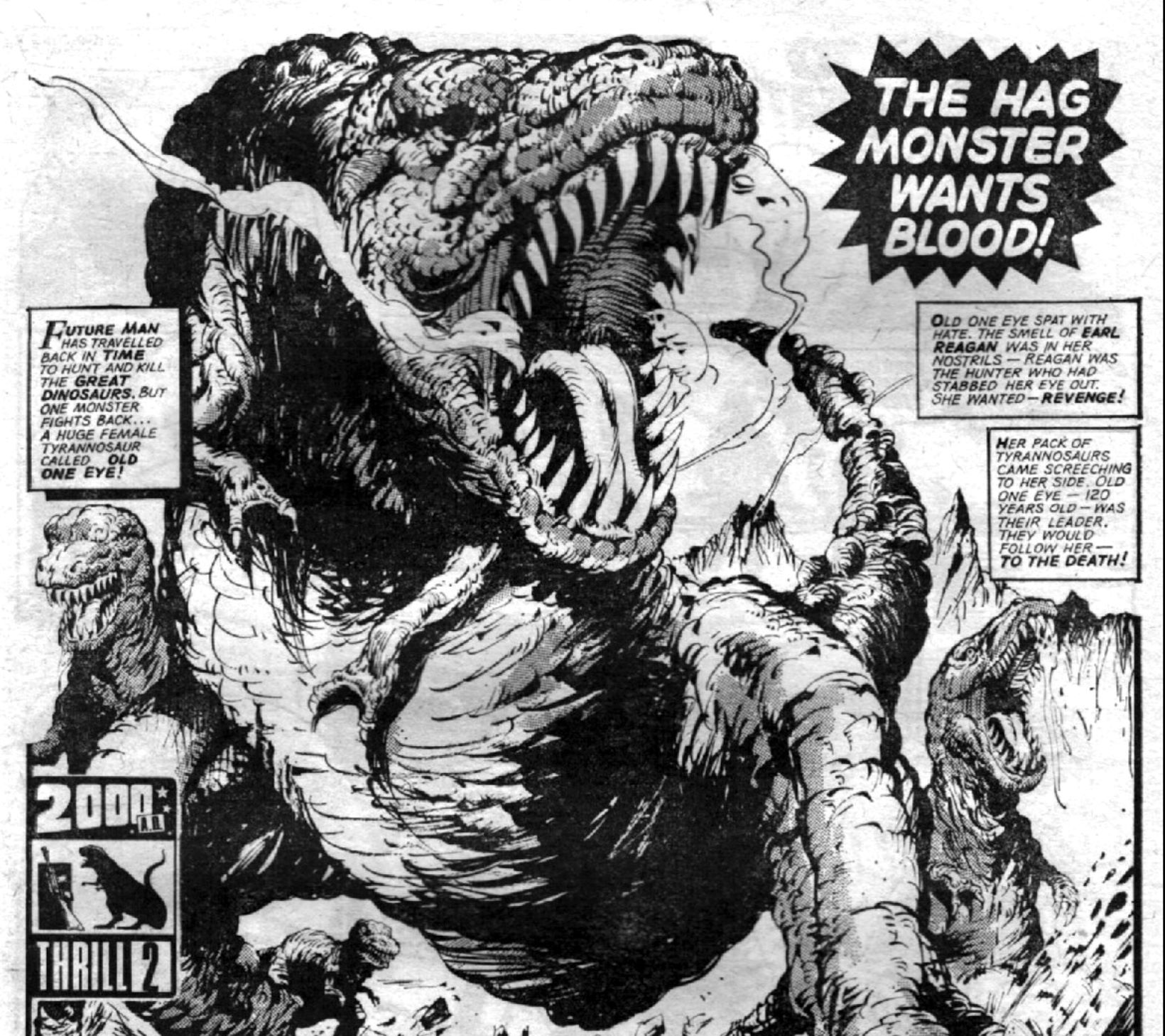
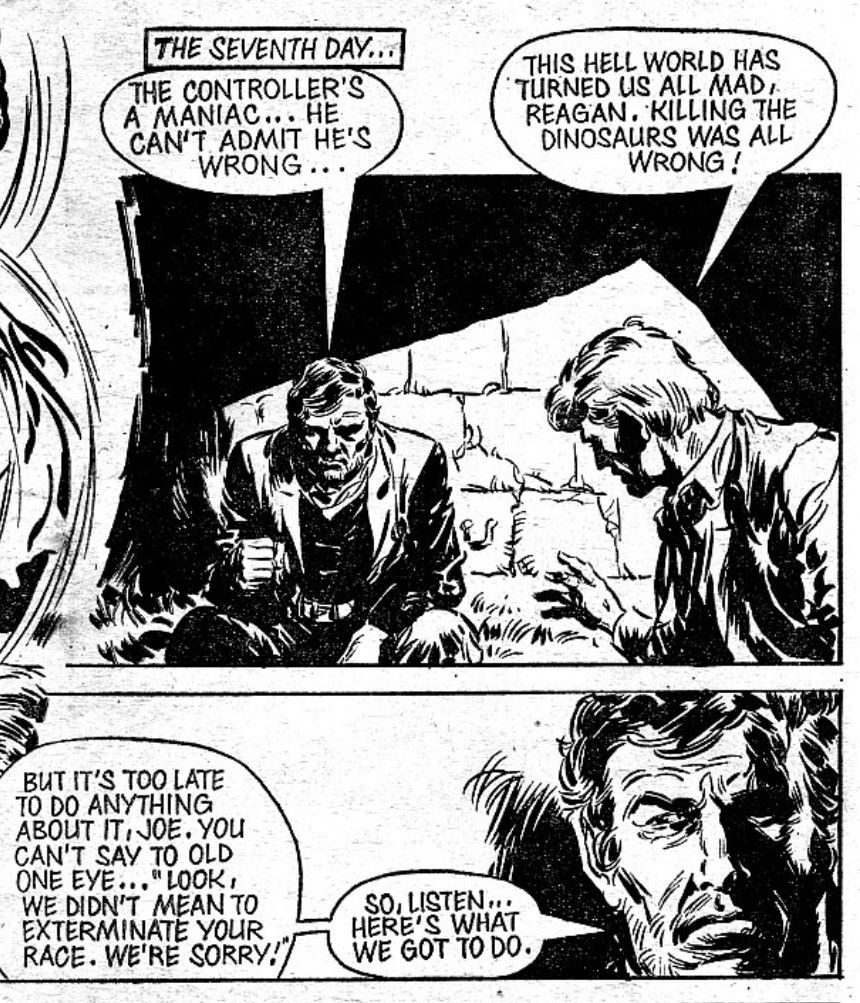


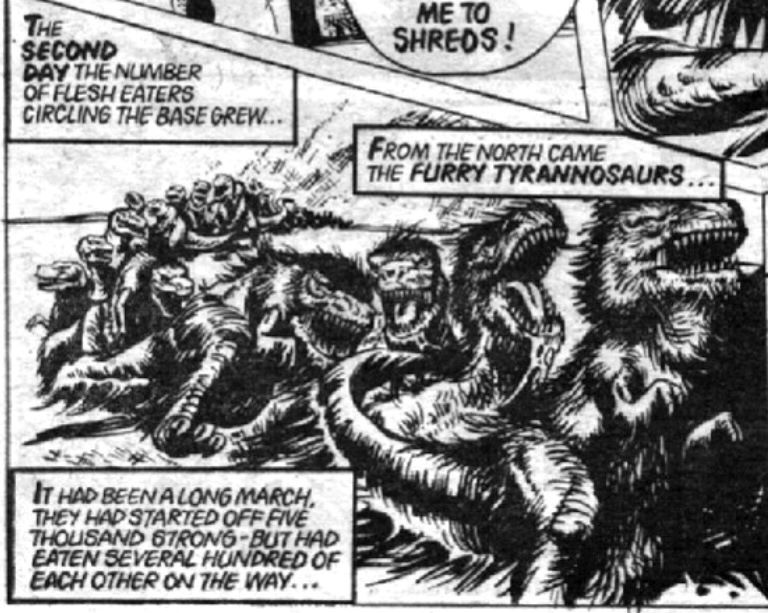
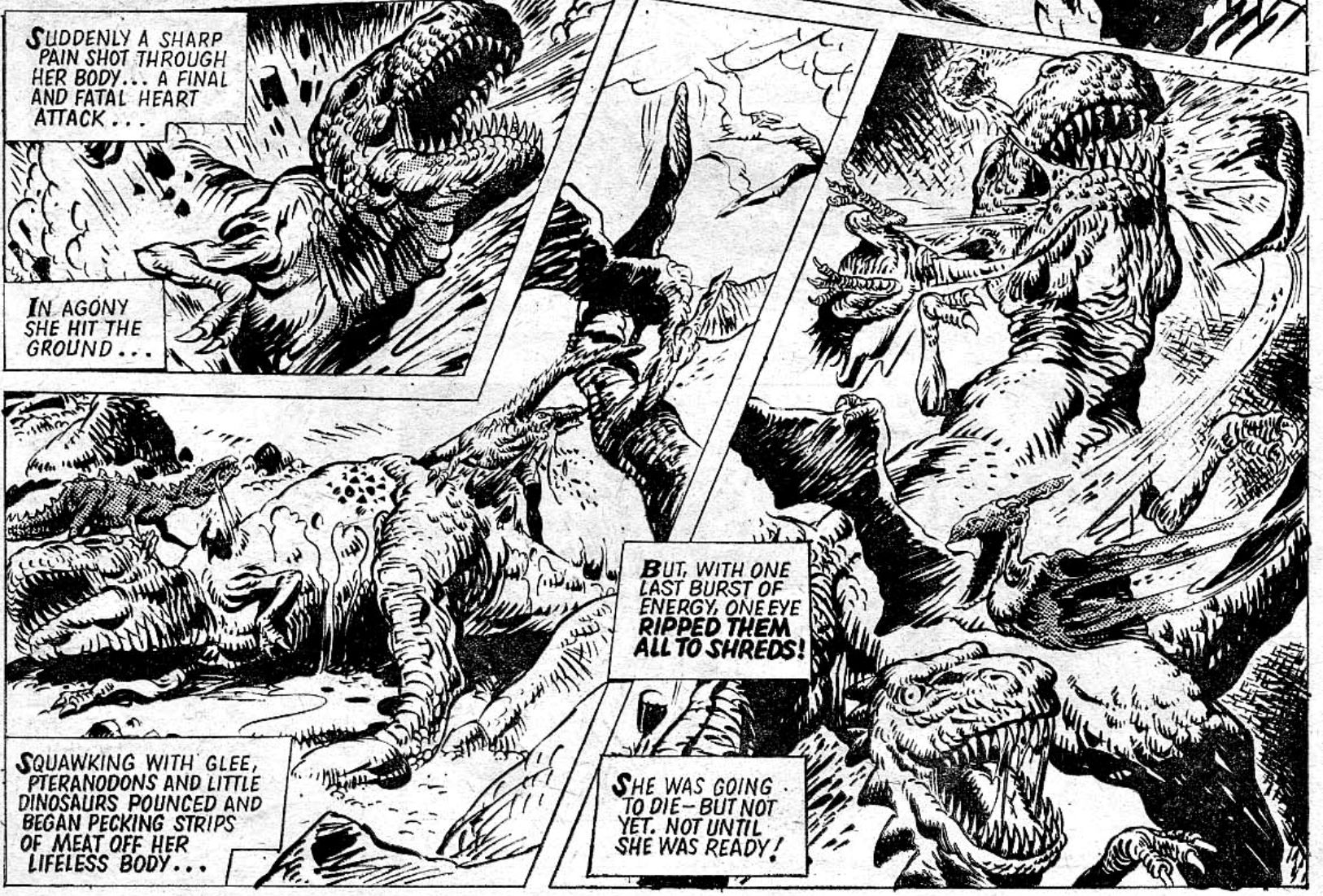
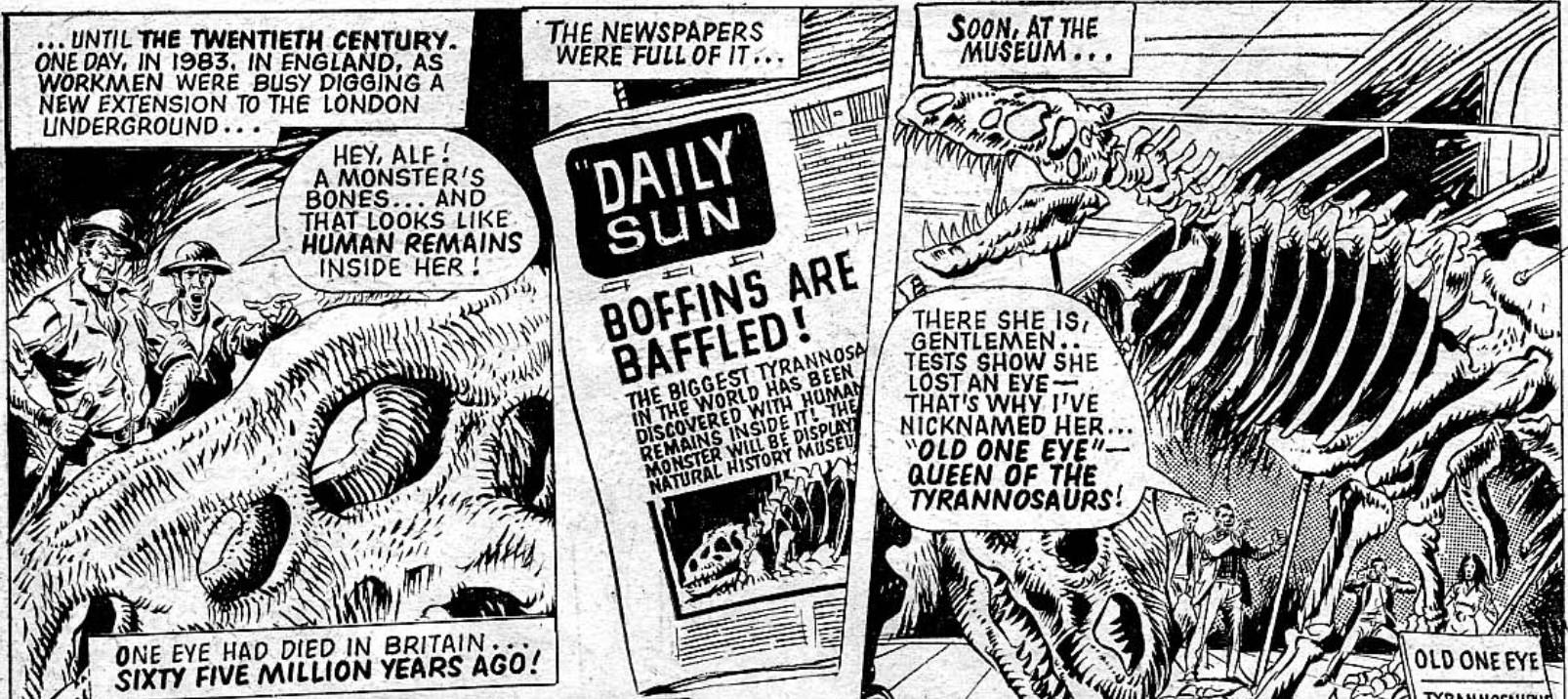
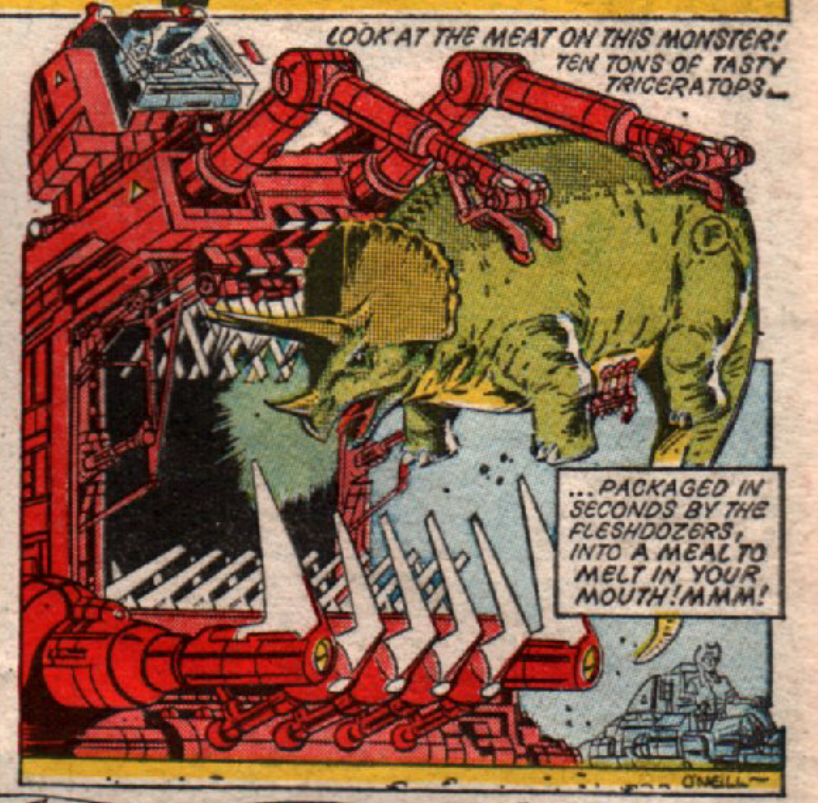
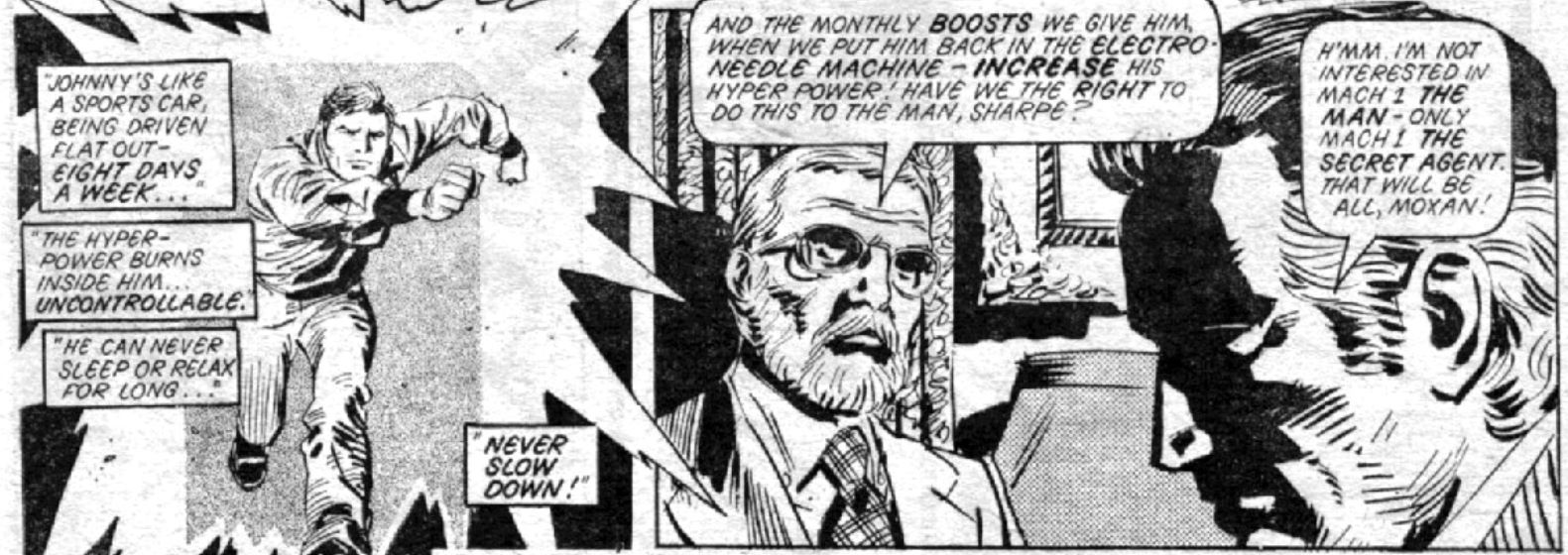
Love this new series, and loved reading about and remembering Flesh again. My memory is that Flesh was a definite highlight, the best story of that era other than Dredd, and you’ve done it justice here, Tom. I was that 8-10 year old boy (10 in 1978), so was squarely in 2000AD’s wheelhouse, and one of my friends in rural Tasmania had recently moved there from England and knew all the best IPC titles to look out for. He and I swapped comics to read, which we bought week by week at the local newsagent, their cover dates a few weeks behind ours because they made their way out to Australia by ship. He was the 2000AD buyer, and I had the complete run of Starlord—my pocket money, 45 cents a week, was 10 cents more than the price of an issue, slightly higher than the price of Tharg’s. I switched to 2000AD on the merger of the two, and at some point acquired a lot of its back issues, almost but not quite back to the beginning. My earliest prog might have been number two. That panel of Old One-Eye atop a diplodocus was in one of them.
I kept up my 2000AD-buying for a few years, into the mid-100s, past the merger with Tornado (which I also bought in its entirety), so I’m looking forward to future entries about stories I know are to come. I stopped somewhere around 13, that pivotal age when one puts away childish things and turns to the serious business of, in my case, computer programming, Advanced Dungeons & Dragons and pop music.
You can guess the sequel. Ten-year-old boys eventually become sixteen-year-old boys looking for cash, and see an ad in the local paper looking for back-issues of 2000AD, and sell their entire collection to some guy for fifty bucks. I still have the knock-off Walkman I bought with the proceeds. I must have thrown in the Tornados, because I don’t have those any more either. I did, at least, keep the Starlords, which now take up a precious two inches on my bookshelves in their home-made slip-case.
I’ve spent way more than fifty bucks on Titan reprints of early strips from 2000AD to relive my memories of it, though of course there are gaps—no jolly green giant in Dredd, no double page colour spreads in the ABC Warriors on Mars or Strontium Dog in Hell. Ah well. Time to add a Flesh reprint to the list, perhaps—or perhaps I’ll just enjoy this moment of memory. After all, posts like these remind me that it’s all still in there somewhere, waiting for me to travel back in time and gorge on it.
I imagine you’re aware, but Rebellion did put out a collection of The Cursed Earth a couple of years ago that put all the censored content — Jolly Green Giant and all — back in.
Gasp! No, I’d missed that—thanks. Might upgrade the old Titan edition on my shelf sometime. (Missed the volume of Flesh reprints in 2011, too, and now it’s £45+ on eBay. Le sigh…)
So that “might” lasted all of five minutes before I swooped in on a copy of the Cursed Earth Uncensored before that, too, can only be found for double the price. Thanks, thekelvingreen! (This is going to be an expensive blog to follow, isn’t it…)
Ha! You’re welcome!
You can’t farm dinosaur flesh from the Cretaceous any more, becuase of woke.
Well there’s a coincidence I’ve just posted an entry in my ‘Completely Self Absorbed Top 100 comics you need to read” thread over at the 2000ad forum. Its not even close to being as well considered and well written as this, and is much more an unequitable gushing about why I love the strip and why its so important to me.
So if anyone wants to read some similar thoughts, expressed with much less elegance and intelligence feel free have a nosey… or not as there nothing I say that isn’t said better here!
https://forums.2000ad.com/index.php?topic=49476.msg1119153#msg1119153
Oh its split into 4 parts due to the amount you can post per reply on the forum these days.
I saw your write-up yesterday Colin and absolutely loved it – so glad you liked my piece! I’m a lurker on the 2000AD forums and should probably post a thread about this series there. I love reading reminiscences by the people who Were There – I’m only a bit younger than you but didn’t start reading the Prog until 1985 and my worry with these pieces is honestly that they’re going to seem somewhat bloodless and analytical compared to the massive enthusiasm so many readers have. So it’s reassuring to know it landed well. Thanks for the link and it’s past time I dug in to the rest of your Top 100!